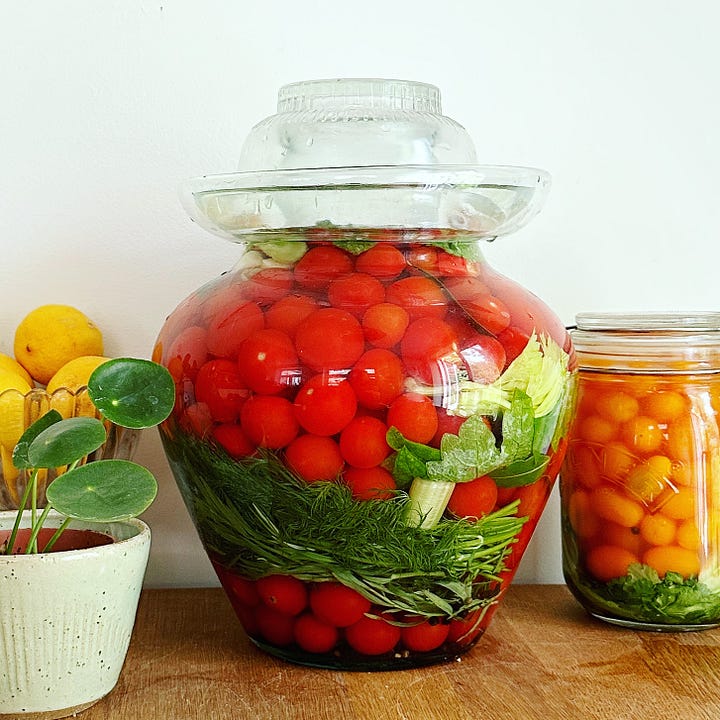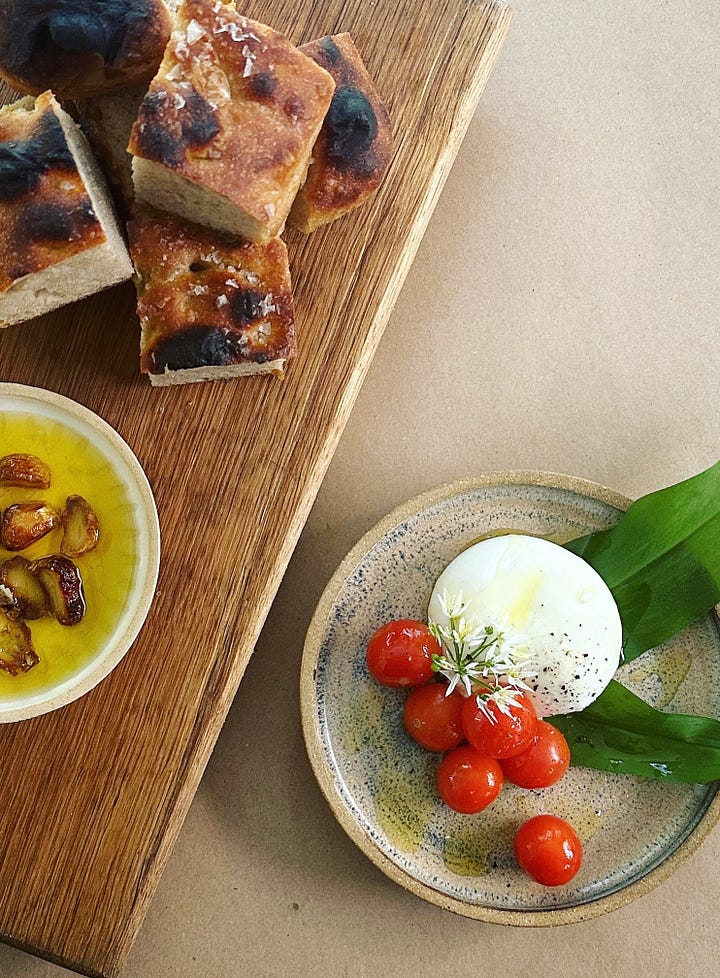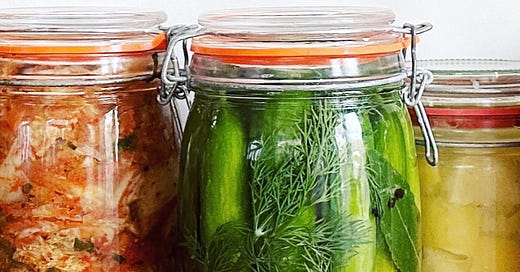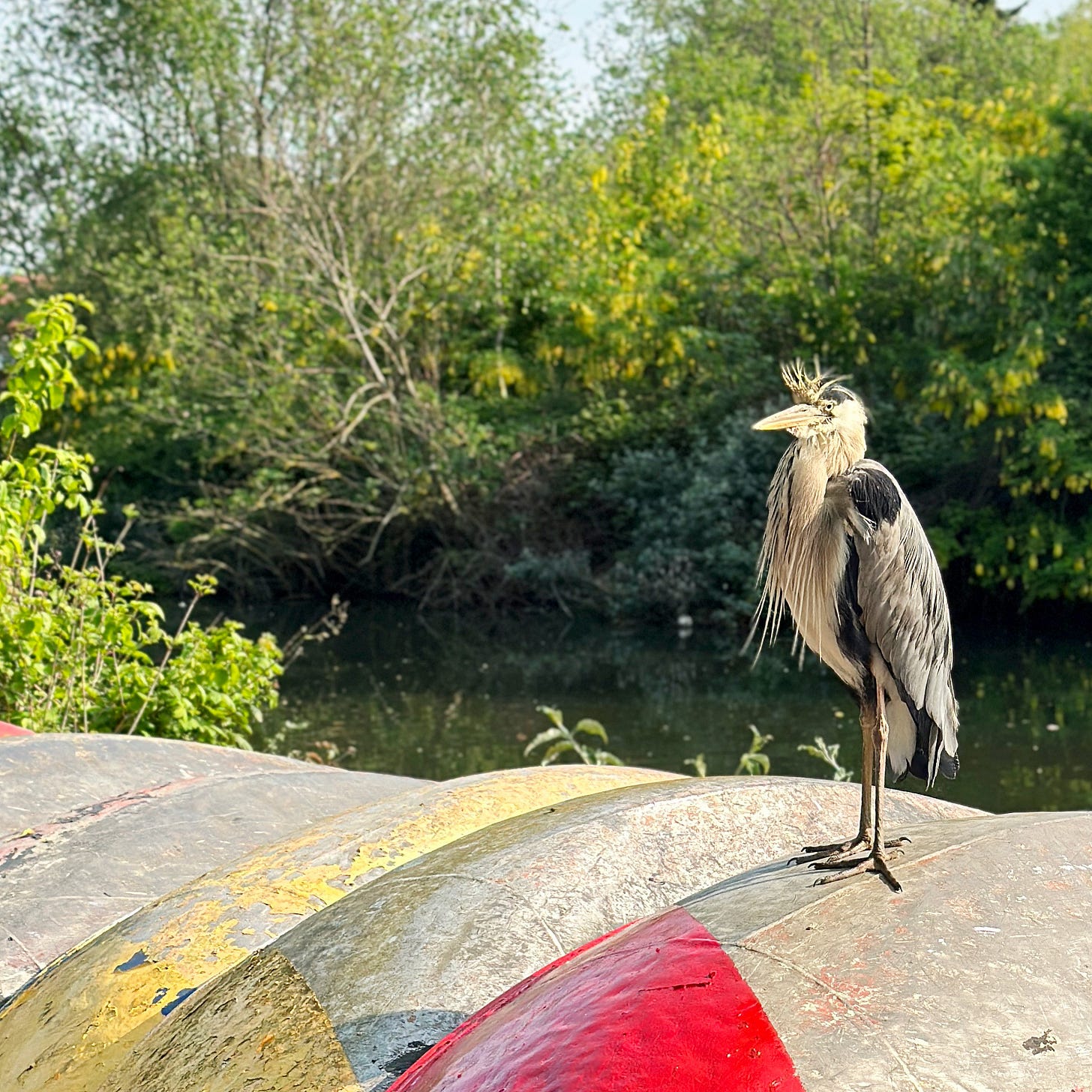In Good Taste #8: Pickled Cucumbers
Brine pickles 101; collective nouns for relatives; Finsbury Park station's hot air balloon mosaics
Well, hello there! How are you?
Good I hope. Thank you so much for being here.
This is possibly my favourite time of year. Long, light evenings; a profusion of green things growing everywhere; ducklings, goslings and other water bird chicks to gawp at on my walks and all the summer produce coming into season.
It’s been a busy week but one I feel more-or-less in control of. I even took a half day off on Wednesday to go to Cambridge (which was looking particularly lovely). I had lunch with my mother and spent a fun evening hanging out with my sister-in-law, niece and nephews since my brother is away for work. It made me think - and not for the first time - that there really ought to be a collective, gender-neutral noun for nieces-and-nephews. My linguistic podcaster friend Helen Zaltzman favours “niecephews”, despite an ambiguous relationship with portmanteau words in general. I don’t love it but it’s better than “niblings” which makes me feel a bit ill. Personally, I am team “sofralia” but don’t hold out much hope of getting it to catch on. Yet why not join me on this doomed quest and use the word in conversation today?
There was also lots of admin (gah!) and lots of teaching (yay!). I had a wonderful Fermentation class at Borough Kitchen in Hampstead where two of the attendees told me it was the best cookery class they’d ever been on. Wonderful (and ego-boosting) to hear. If you’d like to join me at a class or workshop you can see all upcoming ones on the events page of my website or get in touch to book a private class in the comfort of your own home.
Lastly, I saw this heron on my run this morning. Not sure if it was a dude or dudette heron (how does one tell this difference?) but it looked quite smug. That was OK though because I was on a run and therefore also felt quite smug.
So, there have been quite a few fresh subscribers over the past couple of weeks so if you’re new here, welcome, welcome. I’ll just offer a brief explanation of what this newsletter is: it’s a celebration of food in general and lacto-fermentation in particular. Each issue is stand alone, but if you go back through the archive, you’ll find a sort of introductory course should you want one. Recipes for ferments one week followed by ways to use them the next. I also make a tortured link between the microbial cultures of fermentation and culture in general in order to give you a few personal recommendations for exhibitions, books, podcasts etc. that I’ve enjoyed.
That’s more or less it. So far we’ve covered the basic science of lacto-fermentation and made some simple sauerkraut. We talked about other types of kraut and explored a few ways to cook with them.
Today we’re moving along to brine pickles. The science and technique is the same as kraut: we just want to create a salty, oxygen-free environment in which the “bad” bacteria that spoil food can’t survive but in which our friendly lactic acid bacteria thrive. Add some time and patience and - voilà - delicious pickles.
With a kraut we grate or shred the veg and add salt which draws out water, creating a brine. For larger chunks or whole veg, we’re going to need to make the brine ourselves and pour it over the vegetables. I generally recommend 2.5% salt for a kraut, by which I mean 2.5% of the weight of the veg (for example, 25g salt for 1kg cabbage). In a brine pickle it’s slightly different: we’re considering the combined weight of the veg and the water surrounding it. You can do this by putting your jar on a scale and weighing the veg plus enough water to cover them, calculating 2.5% of that total weight and then adding it to the water.
Or you can do what I usually do which is make a 4% brine - ie 4% of the weight of the water (for example 25g salt for one litre of water). Once this brine is added to the veg, the salt percentage of their combined weight will be around the 2.5% mark. It’s less faffy this way.
We’re going to start our brine pickle adventures with something super classic: pickled cucumbers. AKA kosher dills. Let’s go…
Recipe: Pickled Cucumbers
You’ll need a large, clean jar. A 750ml one works well for the quantities below but feel free to scale up or down.
Having said that I generally use a 2.5% salt ratio, here I’m going to confuse matters by recommending a 4% brine. This is because cucumbers have a very high water content. The salty brine will pull water from the cucumbers which will dilute it down to around that 2.5% ratio that we want.
Ingredients
4% brine (16g salt dissolved in 400ml water should be plenty)
2 bay leaves (fresh or dried)
Optional but recommended flavourings: a few dill fronds, 2/3 garlic cloves (peeled but whole), mustard seeds, allspice berries, black peppercorns, coriander seeds (approx 1 tbsp spices total)
10(ish) baby cucumbers
Method
Make a 4% brine. If using spices, boil the water in a pan and add them at this stage for increased flavour. Let the brine cool completely (or it will kill all the lactic acid bacteria). Alternatively make a brine with cold water and just put the spices at the bottom of the jar.
Put the bay leaves in the bottom of your jar and add the dill, garlic etc. if desired.
There are two ends to your cucumbers (you: “duh, obviously”). You can remove the stalk end or not, it’s an aesthetic decision. I quite like to leave it on as it gives the finished cucumbers a recognisable cartoon pickle look. But the opposite end - where the blossom was - must be removed as it contains an enzyme that will make your pickles go mushy and no-one likes a mushy pickle. Just a tiny little slice, a few millimetres is fine.
Add the cucumbers to the jar, packing them vertically, as snugly as you can. This way they prevent each other from floating to the surface once fermentation begins and carbon dioxide is produced.
Pour over the brine (including any spices) and seal the jar.
The cucumbers will take between 3 days and a couple of weeks, depending on whether you like them to retain a little of the sweetness of fresh cucumber or be very tart. Delis in New York tend to sell two types: “half sour” and “full sour” which are fairly self explanatory. They are made by the same method, just left to ferment for different amounts of time. Leave them at room temperature, somewhere out of direct sunlight, “burping” the jar and tasting every day. Move the cucumbers to the fridge when they suit you. They should stay crunchy for several months.
Notes
You ought to be able to get baby cucumbers in the supermarket. They’re widely available, sold in packs of five or six for snacking. If you can’t find them you can use regular cucumbers cut into spears. They won’t be quite as crunchy but are still good. Look for smaller varieties as they tend to be less seedy/watery.
If you can get hold of dill seeds or flowers they are delicious here with a more pronounced flavour than the leafy fronds.
The flavourings are all optional but the bay leaves are crucial as they contain tannins which keep the pickles crisp. You could use vine leaves or tea instead.
As the fermentation process gets going the cucumbers will lose their bright green colour and go more olive-y green or khaki. This is totally normal, as is the brine becoming cloudy.
My upcoming Newington Green supper club menu will feature fermented elements in every course. They’re subtle, just bringing a twist on a classic or a hint of extra flavour. It’s a real labour of love - many of the ingredients are underway already including these red and gold cherry tomatoes, gorgeous little flavour bombs to be served with burrata.


The full menu is as follows:
SYCAMORE SMYTH @ LIZZY’S ON THE GREEN JUNE MENU
Elderflower “Champagne” cocktail
Freshly baked focaccia bread, confit garlic oil
Burrata, fermented cherry tomatoes
Tortelloni filled with ricotta & preserved lemon, pea shoots, pistachio pangrattato
Chicken polpette/Aubergine polpette (V)
Asparagus, griddled courgette, farro & summer herb salad
Roast beet & lentil salad, raspberry vinaigrette, fermented beet crisps, white bean pureé, watercress pesto
Summer berry ice cream profiteroles, dark chocolate sauce, cultured cream, fresh and fermented berries
I'll be serving this menu twice, 6-9pm on June 3rd and 17th before moving on to something new for the July and August dates. Tickets are £45 per person and include a welcome cocktail. I’d really love to see you there.
Cultural Fun
Something I look at a lot but never think to mention are the hot air balloon mosaics on the Piccadilly Line platforms at Finsbury Park tube station.
They’re by an artist called Annabelle Grey, installed in 1983, and I really love them. I change here regularly but they’ve never become backdrop for me. I always try and stand somewhere different on the platform and appreciate the unique patterns on each balloon. This is one if my favourites.
Exciting news from much-lauded newsletter Vittles: Editor in Chief Jonathan Nunn has announced they will be making restaurant coverage a priority. He and his team have such insight into dining out beyond the tiny range of places that usually get critical coverage. They have promised both biryani and ice cream guides to London plus coverage outside the capital. I can’t wait to see what they come up with.
I’ve been enjoying the three-part mini series from the Freakonomics Radio podcast on stolen and looted art (episodes 541-3). It looked at how museums come to have stolen art in their collections and the thorny issue of whether to give it back. It turns out making that decision isn’t even the hardest bit: once you’ve decided to repatriate it, the question is who to?
Bye! See you next week!
In the meantime, if you felt like sharing In Good Taste with friends or family who might enjoy it, you can do so with the button below. It would mean the world to me. Thanks so much.
In Good Taste is a Sycamore Smyth newsletter by me, Clare Heal.
You can also find me on Instagram or visit my website to find information about my catering work, cookery lessons and upcoming events.







